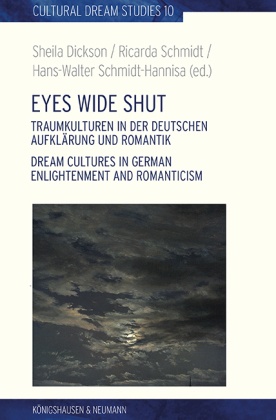Eyes Wide Shut - Traumkulturen in der deutschen Aufklärung und Romantik. Dream Cultures in German Enlightenment and Romanticism
| Verlag | Königshausen & Neumann |
| Auflage | 2024 |
| Seiten | 318 |
| Format | 15,6 x 2,5 x 23,6 cm |
| Gewicht | 490 g |
| Reihe | Cultural Dream Studies / Kulturwissenschaftliche Traumstudien 10 |
| ISBN-10 | 3826089170 |
| ISBN-13 | 9783826089176 |
| Bestell-Nr | 82608917A |
In Bezug auf die kulturelle Bedeutung des Traums kommt es im Jahrhundert zwischen Frühaufklärung, Romantik und beginnender Restauration mehrfach zu radikalen Umwälzungen. In der Aufklärung erklärt man ihn zum psychologisch analysierbaren Phänomen, in der Romantik eröffnet er Einblicke in ein naturphilosophisch gedachtes Unbewusstes. Literatur und Kunst sind an diesen Transformationsprozessen stets aktiv beteiligt. Sie entwickeln eine Vielfalt formal und funktional unterschiedlicher Traumdarstellungen, mitunter auch im Zeichen von Ironie und Sozialkritik. Die in diesem Band versammelten Beiträge zum Traum lenken die Aufmerksamkeit auf bisher wenig beachtete Texte, u.a. von Droste-Hülshoff, Wolzogen, Kant, Goethe und aus dem Magazin zur Erfahrungsseelenkunde; sie beschäftigen sich aber auch mit den diskursiven Verflechtungen von Traumdarstellungen bei Autoren und Künstlern, die in der Traumforschung bereits 'kanonischen' Status genießen, wie Novalis, Tieck, Kleist, E.T.A. Hoffmann u nd Füßli.
In terms of the cultural significance of the dream, the century between the early Enlightenment, Romanticism and the beginning of the Restoration was a period of radical shifts. The Enlightenment defined it as a subject for psychological analysis, in Romanticism it offered insights into an unconscious which was conceived in terms of natural philosophy. Literature and art were always actively involved in these transformation processes. They developed a variety of formally and functionally different dream representations, which were on occasion characterised by irony and social criticism. The essays collected in this volume draw attention to previously neglected texts by, among others, Droste-Hülshoff, Wolzogen, Kant, Goethe and contributors to the Magazin zur Erfahrungsseelenkunde. Additionally, they offer new insights into the discursive context of dream representations by authors and artists who already enjoy 'canonical' status in dream studies, such as Novalis, Tieck, Kleist, E. T.A. Hoffmann and Fuseli.

